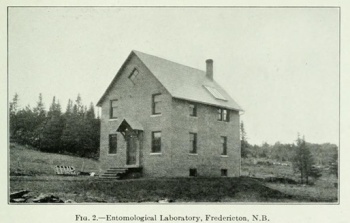Building Name: Bio-Engineering Institute
Other Names: R.N. Scott Hall, Biomedical Engineering Building, Institute of Biomedical Engineering, Geology Annex, Dominion Entomological Laboratory
Civic Address: 25 Dineen Dr.
Sod Turning: [ca. 1915]
Cornerstone Laying: [ca. 1915]
Opened for Use: [Between April and November 1915] (as Dominion Entomological Lab)
Official Opening: 27 May 1982 (Bio-Engineering Institute opening); 24 May 2002 (R.N. Scott Hall opening)
Architect: Unknown
Named for: Robert N. Scott, director of the Bio-engineering institute for 25 years.
Renovations/changes/additions: Moved up-hill by approximately 80 feet in 1929. Front section added, rear modified, greenhouse added in 1930’s. Renovations took place in 1954 to make the building ready for the new university departments moving in, as well as the arrival of the Provincial Government's Mines Branch. In May 2002 the R.N. Scott Hall addition, a 14,000-square-foot expansion of the Institute, was officially opened.
Notes: Built by the Dominion Government on the University Grounds, the original building was a two story solid brick construction, measuring 24 x 30 feet, with a basement and an attic. It served as the Dominion Entomological Laboratory. In the 1930s the building then became the Forest Biology Laboratory of the Federal Department of Agriculture until 1954, when the building was given to UNB by the Government of Canada. At this time, the entomology lab moved into the new Forest Biology Laboratory, and the building was used as office space for the departments of psychology, sociology, anthropology, biology, forestry. It was also used as space for a public relations office, the Book Store, the Drama Society, and the Mines Branch of the New Brunswick Department of Land and Mines. Shortly thereafter, in 1955, all rooms within the building, with the exception of the greenhouse and two basement rooms, were leased to the Mines Branch, which required more space due to the discovery of base metals in Bathurst. With the opening of the Centennial Building in 1967, the Mines Branch moved out and the building was once again in UNB's hands; it was renamed the Geology Annex. In 1981 the Geology Department vacated the building, and in June of that year the Bio-Engineering Institute moved in.
In 1962 the Technical Assistance and Research Group for Physical Rehabilitation (TARGPR) was formed, largely on the efforts of Dr. Lynn Bashow, who was looking for technical aid in rehabilitating quadriplegic patients, and in 1965 formally became the Bio-Engineering Institute. Today the building houses the Biomedical Engineering department.
Source(s):
- Leroux, John. Building A University: The Architecture of UNB. Fredericton: Goose Lane Editions, 2010, p. 51, 123.
- Montague, Susan. A Pictorial History of the University of New Brunswick. University of New Brunswick, 1992, p. 66, 168-169.
- UA Case 123; Section 3; Box 1; Biomedical-Engineering Institute (R.N. Scott Hall).
- Hewitt, C. Gordon. Report of the Dominion Entomologist for the Year Ending March 1916. Ottawa: J. de L. Taché, 1917.
- Main Page
- Anniversaries
- Brief History of UNB
- Buildings
- Faculties and Departments
- Governance and Administrative Positions
- Lecture Series
- Official University Events and Symbols
- People of UNB
- Plaques, Monuments and Structures
- Prizes and Awards
- Sports and Athletics
- Student Clubs and Societies
- Student Events and Escapades
- University Publications
- Women's Sports at UNB
- About UNB Archives and Special Collections
Request an Appointment
Prior arrangements must be made for the retrieval of this material. Please email archives@unb.ca to make an appointment.
Procedures
Help Desk Hours
- Monday - Friday
- 10:00 am - 12:00 pm
- 1:00 pm - 4:00 pm
Contact Us
- 5th Floor, Harriet Irving Library
- University of New Brunswick
- 5 Macaulay Lane, Box 7500
- Fredericton, NB E3B 5H5 Canada
- archives@unb.ca
- Staff Directory
![Entomological Building, [between 1952-1956]. UA RG 350; Series 8; Sub-series 1; File 2, UNB25.](/sites/default/files/styles/featured/public/unbhistory/Entomological_building.jpg?itok=csNWd_di)
